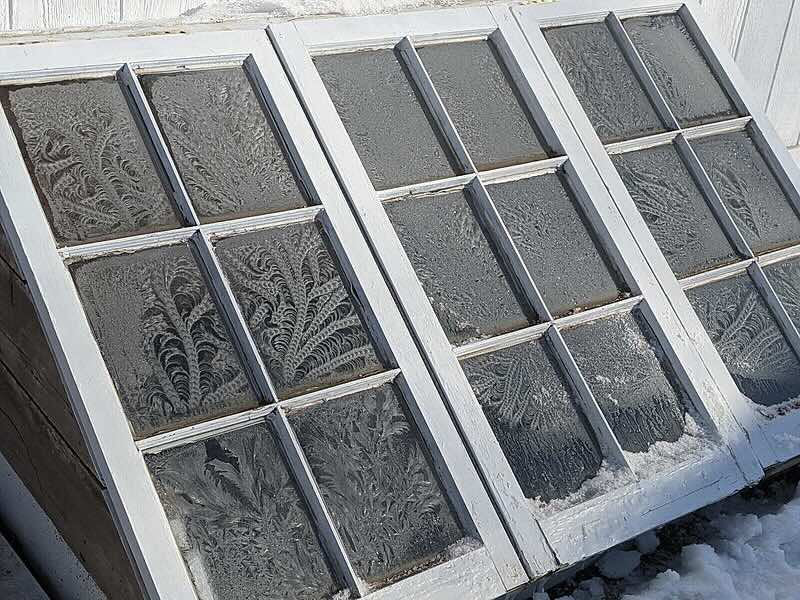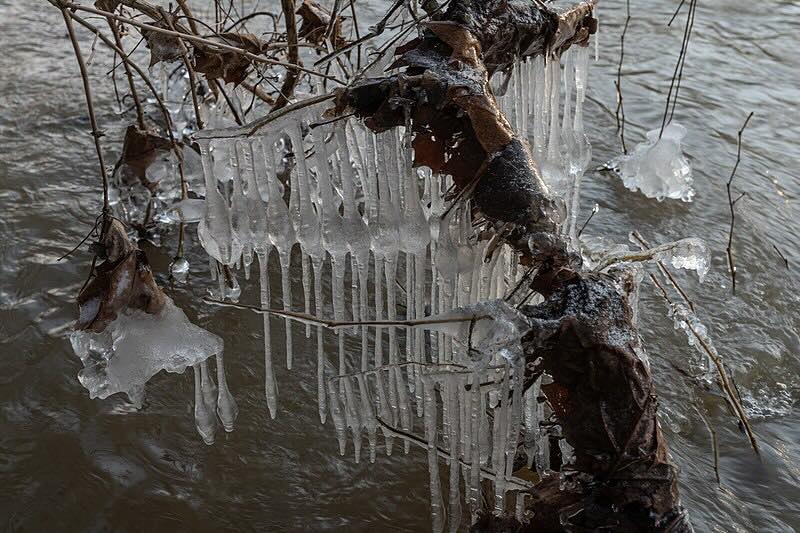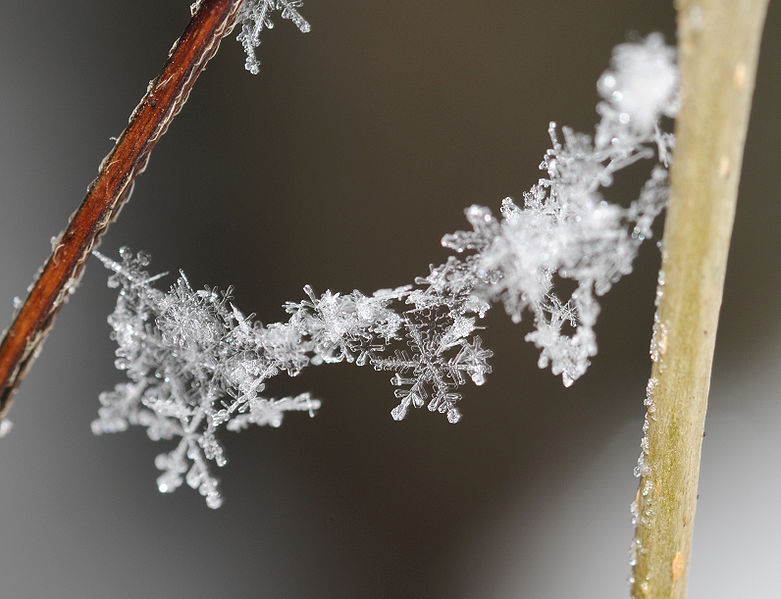As the winter season arrives, the world transforms into a breathtaking wonderland of snow-covered landscapes and glistening frost. But have you ever wondered about the science behind these mesmerizing winter phenomena? In this blog post, we’ll delve into the fascinating world of snow, frost, and ice, uncovering the scientific processes that create these wintry wonders.
Frost: Nature’s Delicate Artwork
 Image source: Skiba, Justin M., CC BY-SA 4.0, via Wikimedia Commons
Image source: Skiba, Justin M., CC BY-SA 4.0, via Wikimedia Commons
On cold winter mornings, we often see intricate frost patterns delicately etched onto windows and leaves. Frost forms through a process called deposition. When the air is humid, and the temperature drops below freezing, water vapor directly transitions from a gas to a solid, forming frost on surfaces. The unique patterns we see are a result of the interaction between humidity levels, surface characteristics, and the duration of freezing temperatures.
Here’s a step-by-step explanation of how frosty patterns form:
- Cold surface. Frost patterns require a cold surface to form.
- Moisture in the air. The air around us contains water vapor in the form of tiny water droplets. This moisture can come from various sources, including indoor humidity, breathing, cooking, or outdoor moisture in the air.
- Temperature difference. The temperature of the surface is lower than the dew point of the air. The dew point is the temperature at which air becomes saturated with moisture and can no longer hold the vapor. When the air near the window cools down to its dew point temperature or below, it reaches a state of saturation. As a result, the excess moisture begins to condense.
- Condensation. The moisture in the air condenses into tiny water droplets or ice crystals on the cold surface. This is similar to how dew forms on the grass and other surfaces outdoors in the early morning when the temperature drops.
- Ice crystal growth. When condensation starts, frost patterns can continue their growth. The shape and size of the frost crystals depend on various factors. These factors include the temperature gradient across the window, the air humidity, and any impurities or irregularities on the surface.
- Pattern formation. Frost patterns often appear in intricate and beautiful designs. This is because the microscopic imperfections and irregularities on the surface influence the initial condensation points and the subsequent snow crystal formation. These patterns can take on various forms, such as fern-like patterns, feathery frost, or simple ice crystals.
The Science of Ice Formation
 Image source: Matthew.kowal, CC BY-SA 4.0, via Wikimedia Commons
Image source: Matthew.kowal, CC BY-SA 4.0, via Wikimedia Commons
From frozen ponds to icicles hanging from rooftops, ice is a ubiquitous presence during winter. Understanding the process of ice formation is essential for both practical and scientific reasons. When water temperatures drop below freezing, water molecules slow down and arrange themselves into a regular crystalline structure, forming ice. The process of ice formation involves several key steps:
- Cooling. First, the substance cools down below its freezing point. This is the temperature at which it changes from liquid to solid: 32°F or 0°C. When the temperature drops, the liquid molecules move slower and have less energy.
- Nucleation. Small ice crystals called ice nuclei or ice seeds form. They form either by themselves or with the help of dirt or surfaces that help the ice grow. In clean water, nucleation can be harder because it needs more energy.
- Growth. The liquid molecules join the ice crystals as they freeze. The ice crystal gets bigger as more liquid molecules join it.
- Warming. The liquid molecules lose some energy when they freeze. This energy comes out as heat (called the latent heat of fusion). This is why you feel warm when you touch ice as it melts in your hand.
- Spreading. Water gets bigger when it freezes. This is because of the way the water molecules line up in a crystal.
- Freezing. All the liquid changes into solid, forming ice.
You should also know that the freezing point of a substance can change depending on pressure and other things in it. For example, putting salt in water makes it freeze at a lower temperature, which is why salt is used to melt ice on roads.
The Marvel of Snowflakes
 Image source: Thomas Bresson, CC BY 2.0, via Wikimedia Commons
Image source: Thomas Bresson, CC BY 2.0, via Wikimedia Commons
No two snowflakes are alike, and this uniqueness is a result of intricate processes occurring in the clouds. Snowflake formation happens when supercooled water droplets freeze around tiny dust particles in the atmosphere, creating ice crystals. As these ice crystals ascend and descend within the clouds, they collect more water vapor and grow in size, developing their six-sided, hexagonal structures. The exact shape of a snowflake depends on the temperature and humidity conditions during its formation, resulting in an astounding variety of snowflake patterns.
This is how snowflakes are made:
- Water vapor in the air. Snowflakes start with water vapor in the air.
- Cooling. The next step is to cool down the air. This can happen in different ways, such as air going up, air losing heat, or air touching cold things (like the ground in winter). When the air gets colder, it can’t hold as much water vapor. Nucleation. To make snowflakes, you need small ice nuclei or seed crystals. These can come from different sources. Sometimes, dirt, tiny ice pieces, or other things in the air act as nuclei. Water drops that are already frozen or very cold can also become nuclei.
- Growth. Water vapor molecules in the air stick to the nuclei and freeze. The ice crystals get bigger as more water vapor molecules join them. This depends a lot on the temperature and happens in a six-sided shape. That’s why snowflakes have six sides.
- Branching and shaping. As the ice crystal gets bigger, it grows branches or arms. How the snowflake looks depends on temperature, moisture, and other atmospheric conditions. The 1. beautiful and even patterns of snowflakes come from the special way water molecules line up in the crystal.
- Sticking together. Sometimes, snowflakes bump into other ice crystals in the air and join together. This can make bigger and more complicated snowflakes.
- Falling. When the snowflake is big and heavy enough, it falls to the ground as snow.
Conclusion
Winter weather is a remarkable display of the complexities and beauty of nature. From frost patterns to the formation of ice crystals, we’ve explored the science behind these winter phenomena. Here’s a table summarizing the formation of these winter wonders as well as the factors that influence this formation:
| Phenomenon | Formation Process | Influencing Factors |
|---|---|---|
| Frost | Deposition (air humidity, temperature drop) | Surface characteristics, temperature gradient |
| Ice | Cooling, nucleation, growth, spreading | Impurities, pressure, latent heat of fusion |
| Snowflakes | Cooling, nucleation, growth, branching | Temperature, humidity, atmospheric conditions |
Frost, ice, and snowflakes have amazing science behind them, helping us enjoy the winter season more. Stay safe and warm during this wonderful time of the year.






